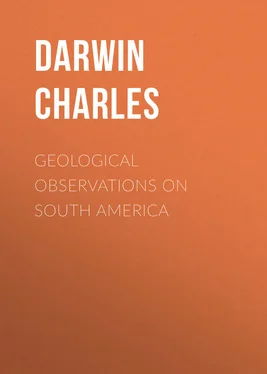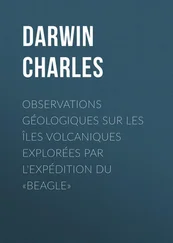Charles Darwin - Geological Observations on South America
Здесь есть возможность читать онлайн «Charles Darwin - Geological Observations on South America» — ознакомительный отрывок электронной книги совершенно бесплатно, а после прочтения отрывка купить полную версию. В некоторых случаях можно слушать аудио, скачать через торрент в формате fb2 и присутствует краткое содержание. Жанр: foreign_antique, foreign_prose, на английском языке. Описание произведения, (предисловие) а так же отзывы посетителей доступны на портале библиотеки ЛибКат.
- Название:Geological Observations on South America
- Автор:
- Жанр:
- Год:неизвестен
- ISBN:нет данных
- Рейтинг книги:3 / 5. Голосов: 1
-
Избранное:Добавить в избранное
- Отзывы:
-
Ваша оценка:
- 60
- 1
- 2
- 3
- 4
- 5
Geological Observations on South America: краткое содержание, описание и аннотация
Предлагаем к чтению аннотацию, описание, краткое содержание или предисловие (зависит от того, что написал сам автор книги «Geological Observations on South America»). Если вы не нашли необходимую информацию о книге — напишите в комментариях, мы постараемся отыскать её.
Geological Observations on South America — читать онлайн ознакомительный отрывок
Ниже представлен текст книги, разбитый по страницам. Система сохранения места последней прочитанной страницы, позволяет с удобством читать онлайн бесплатно книгу «Geological Observations on South America», без необходимости каждый раз заново искать на чём Вы остановились. Поставьте закладку, и сможете в любой момент перейти на страницу, на которой закончили чтение.
Интервал:
Закладка:
(DIAGRAM 5. SECTION OF PLAINS AT THE MOUTH OF THE RIO SANTA CRUZ.
From East (sea level) to West (high):
Terrace 1. (sloping) 355 Ba. M. Shells on surface. 463 Ba. M.
Terrace 2. 710 An. M.
Terrace 3. 840 An. M.)
On the southern side of the mouth of the Santa Cruz we have Diagram 5, which I am able to give with more detail than in the foregoing cases.
The plain marked 355 feet (as ascertained by the barometer and by angular measurement) is a continuation of the above-mentioned 330 feet plain: it extends in a N.W. direction along the southern shores of the estuary. It is capped by gravel, which in most parts is covered by a thin bed of sandy earth, and is scooped out by many flat-bottomed valleys. It appears to the eye quite level, but in proceeding in a S.S.W. course, towards an escarpment distant about six miles, and likewise ranging across the country in a N.W. line, it was found to rise at first insensibly, and then for the last half-mile, sensibly, close up to the base of the escarpment: at this point it was 463 feet in height, showing a rise of 108 feet in the six miles. On this 355-463 feet plain, I found several shells of Mytilus Magellanicus and of a Mytilus, which Mr. Sowerby informs me is yet unnamed, though well-known as recent on this coast; Patella deaurita; Fusus, I believe, Magellanicus, but the specimen has been lost; and at the distance of four miles from the coast, at the height of about four hundred feet, there were fragments of the same Patella and of a Voluta (apparently V. ancilla) partially embedded in the superficial sandy earth. All these shells had the same ancient appearance with those from the foregoing localities. As the tides along this part of the coast rise at the Syzygal period forty feet, and therefore form a well-marked beach-line, I particularly looked out for ridges in crossing this plain, which, as we have seen, rises 108 feet in about six miles, but I could not see any traces of such. The next highest plain is 710 feet above the sea; it is very narrow, but level, and is capped with gravel; it abuts to the foot of the 840 feet plain. This summit-plain extends as far as the eye can range, both inland along the southern side of the valley of the Santa Cruz, and southward along the Atlantic.
THE VALLEY OF THE R. SANTA CRUZ.
This valley runs in an east and west direction to the Cordillera, a distance of about one hundred and sixty miles. It cuts through the great Patagonian tertiary formation, including, in the upper half of the valley, immense streams of basaltic lava, which as well as the softer beds, are capped by gravel; and this gravel, high up the river, is associated with a vast boulder formation. (I have described this formation in a paper in the "Geological Transactions" volume 6 page 415.) In ascending the valley, the plain which at the mouth on the southern side is 355 feet high, is seen to trend towards the corresponding plain on the northern side, so that their escarpments appear like the shores of a former estuary, larger than the existing one: the escarpments, also, of the 840 feet summit-plain (with a corresponding northern one, which is met with some way up the valley), appear like the shores of a still larger estuary. Farther up the valley, the sides are bounded throughout its entire length by level, gravel-capped terraces, rising above each other in steps. The width between the upper escarpments is on an average between seven and ten miles; in one spot, however, where cutting through the basaltic lava, it was only one mile and a half. Between the escarpments of the second highest terrace the average width is about four or five miles. The bottom of the valley, at the distance of 110 miles from its mouth, begins sensibly to expand, and soon forms a considerable plain, 440 feet above the level of the sea, through which the river flows in a gut from twenty to forty feet in depth. I here found, at a point 140 miles from the Atlantic, and seventy miles from the nearest creek of the Pacific, at the height of 410 feet, a very old and worn shell of Patella deaurita. Lower down the valley, 105 miles from the Atlantic (longitude 71 degrees W.), and at an elevation of about 300 feet, I also found, in the bed of the river, two much worn and broken shells of the Voluta ancilla, still retaining traces of their colours; and one of the Patella deaurita. It appeared that these shells had been washed from the banks into the river; considering the distance from the sea, the desert and absolutely unfrequented character of the country, and the very ancient appearance of the shells (exactly like those found on the plains nearer the coast), there is, I think, no cause to suspect that they could have been brought here by Indians.
The plain at the head of the valley is tolerably level, but water-worn, and with many sand-dunes on it like those on a sea-coast. At the highest point to which we ascended, it was sixteen miles wide in a north and south line; and forty-five miles in length in an east and west line. It is bordered by the escarpments, one above the other, of two plains, which diverge as they approach the Cordillera, and consequently resemble, at two levels, the shores of great bays facing the mountains; and these mountains are breached in front of the lower plain by a remarkable gap. The valley, therefore, of the Santa Cruz consists of a straight broad cut, about ninety miles in length, bordered by gravel-capped terraces and plains, the escarpments of which at both ends diverge or expand, one over the other, after the manner of the shores of great bays. Bearing in mind this peculiar form of the land – the sand-dunes on the plain at the head of the valley – the gap in the Cordillera, in front of it – the presence in two places of very ancient shells of existing species – and lastly, the circumstance of the 355-453 feet plain, with the numerous marine remains on its surface, sweeping from the Atlantic coast, far up the valley, I think we must admit, that within the recent period, the course of the Santa Cruz formed a sea-strait intersecting the continent. At this period, the southern part of South America consisted of an archipelago of islands 360 miles in a north and south line. We shall presently see, that two other straits also, since closed, then cut through Tierra del Fuego; I may add, that one of them must at that time have expanded at the foot of the Cordillera into a great bay (now Otway Water) like that which formerly covered the 440 feet plain at the head of the Santa Cruz.
(DIAGRAM 6. NORTH AND SOUTH SECTION ACROSS THE TERRACES BOUNDING THE VALLEY OF THE RIVER SANTA CRUZ, HIGH UP ITS COURSE.
The height of each terrace, above the level of the river (furthest to nearest to the river) in feet:
A, north and south: 1,122
B, north and south: 869
C, north and south: 639
D, north: not measured. D, north? (suggest south): 185
E: 20
Bed of River.
Vertical scale 1/20 of inch to 100 feet; but terrace E, being only twenty feet above the river, has necessarily been raised. The horizontal distances much contracted; the distance from the edge of A North to A South being on an average from seven to ten miles.) I have said that the valley in its whole course is bordered by gravel- capped plains. The section (Diagram 6), supposed to be drawn in a north and south line across the valley, can scarcely be considered as more than illustrative; for during our hurried ascent it was impossible to measure all the plains at any one place. At a point nearly midway between the Cordillera and the Atlantic, I found the plain (A north) 1,122 feet above the river; all the lower plains on this side were here united into one great broken cliff: at a point sixteen miles lower down the stream, I found by measurement and estimation that B (north) was 869 above the river: very near to where A (north) was measured, C (north) was 639 above the same level: the terrace D (north) was nowhere measured: the lowest E (north) was in many places about twenty feet above the river. These plains or terraces were best developed where the valley was widest; the whole five, like gigantic steps, occurred together only at a few points. The lower terraces are less continuous than the higher ones, and appear to be entirely lost in the upper third of the valley. Terrace C (south), however was traced continuously for a great distance. The terrace B (north), at a point fifty- five miles from the mouth of the river, was four miles in width; higher up the valley this terrace (or at least the second highest one, for I could not always trace it continuously) was about eight miles wide. This second plain was generally wider than the lower ones – as indeed follows from the valley from A (north) to A (south) being generally nearly double the width of from B (north) to B (south). Low down the valley, the summit-plain A (south) is continuous with the 840 feet plain on the coast, but it is soon lost or unites with the escarpment of B (south). The corresponding plain A (north), on the north side of the valley, appears to range continuously from the Cordillera to the head of the present estuary of the Santa Cruz, where it trends northward towards Port St. Julian. Near the Cordillera the summit-plain on both sides of the valley is between 3,200 and 3,300 feet in height; at 100 miles from the Atlantic, it is 1,416 feet, and on the coast 840 feet, all above the sea-beach; so that in a distance of 100 miles the plain rises 576 feet, and much more rapidly near to the Cordillera. The lower terraces B and C also appear to rise as they run up the valley; thus D (north), measured at two points twenty-four miles apart, was found to have risen 185 feet. From several reasons I suspect, that this gradual inclination of the plains up the valley, has been chiefly caused by the elevation of the continent in mass, having been the greater the nearer to the Cordillera.
Читать дальшеИнтервал:
Закладка:
Похожие книги на «Geological Observations on South America»
Представляем Вашему вниманию похожие книги на «Geological Observations on South America» списком для выбора. Мы отобрали схожую по названию и смыслу литературу в надежде предоставить читателям больше вариантов отыскать новые, интересные, ещё непрочитанные произведения.
Обсуждение, отзывы о книге «Geological Observations on South America» и просто собственные мнения читателей. Оставьте ваши комментарии, напишите, что Вы думаете о произведении, его смысле или главных героях. Укажите что конкретно понравилось, а что нет, и почему Вы так считаете.












